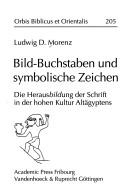| Listing 1 - 10 of 54 | << page >> |
Sort by
|
Book
ISBN: 9783412370053 Year: 2008 Volume: 21 Publisher: Köln : Böhlau,
Abstract | Keywords | Export | Availability | Bookmark
 Loading...
Loading...Choose an application
- Reference Manager
- EndNote
- RefWorks (Direct export to RefWorks)
Inscriptions, Egyptian. --- Visual poetry, Egyptian. --- Egyptian language --- Poetry, Ancient --- Egyptian poetry. --- Stele (Archaeology) --- Inscriptions égyptiennes --- Egyptien (Langue) --- Poésie égyptienne --- Stèles (Archéologie) --- Writing, Hieroglyphic. --- Ecriture hiéroglyphique --- Visual poetry, Egyptian --- Poésie visuelle égyptienne --- Poésie ancienne --- Inscriptions égyptiennes --- Poésie visuelle égyptienne --- Poésie ancienne --- Poésie égyptienne --- Stèles (Archéologie) --- Ecriture hiéroglyphique
Book
ISBN: 9789004167667 9004167668 9786612949258 9004181091 128294925X 9789004181090 Year: 2010 Volume: 27 Publisher: Leiden Boston Brill
Abstract | Keywords | Export | Availability | Bookmark
 Loading...
Loading...Choose an application
- Reference Manager
- EndNote
- RefWorks (Direct export to RefWorks)
Egyptian historiography is determined by the fact that transmission of the historical record is left to chance. Ludwig Morenz therefore develops a method of “fragmentarily thick description,” borrowing terminology from anthropologist Clifford Geertz, as a way of addressing the holes left in the record while still arriving at as complete a picture of the third century BCE Gebelein society as possible. From this localized perspective, a new understanding of the region’s culture, including conceptualizations of the landscape, the socio-economic situation, the mentality of the people and their methods of discourse, arises. Even with this new method the private realities of the men, women, and children can remain in shadows. However, it is possible, as a result of the descriptive model, to better understand the sources at hand and to draw connections among intellectual-, economic-, and social-historical frameworks. Utilizing Morenz’s method widens our understanding of the traditionally undervalued “dark” times of the third century BCE Gebelein region. Upon closer examination of the socio-economic and mentalities history, the transformation of Egyptian society emerges as colorful and contradictory.
Gebelein Site (Egypt) --- Egypt --- History --- Pathyris Site (Egypt) --- Antiquities --- Egypt - History - 332-30 B.C. --- Égypte --- 332-30 av. J.-C.
Book
ISBN: 3447038829 9783447038829 Year: 1996 Volume: 29 Publisher: Wiesbaden Harrassowitz
Abstract | Keywords | Export | Availability | Bookmark
 Loading...
Loading...Choose an application
- Reference Manager
- EndNote
- RefWorks (Direct export to RefWorks)
Book
ISBN: 9783727817496 9783525543894 Year: 2014 Publisher: Fribourg Academic press
Abstract | Keywords | Export | Availability | Bookmark
 Loading...
Loading...Choose an application
- Reference Manager
- EndNote
- RefWorks (Direct export to RefWorks)
Book
ISBN: 9783868933147 386893314X Year: 2019 Volume: 3 Publisher: Berlin : EB Verlag,
Abstract | Keywords | Export | Availability | Bookmark
 Loading...
Loading...Choose an application
- Reference Manager
- EndNote
- RefWorks (Direct export to RefWorks)
In diesem Band wird dem Rumpelstilzchen-Motivs vom geheimen Namen nachgegangen. In der altägyptischen Kultur galt der wahre Name des Sonnengottes als so verborgen wie mächtig. Im Horizont dieser Vorstellung wurde er in besonderen visuell-poetischen Schreibvarianten mit Bedeutung aufgeladen, und wir können dies als eine Art protokabbalistische Sprachpraxis verstehen. Das Motiv des geheimen und mächtigen, vielleicht sogar allmächtigen, Gottesnamens gründet im sprachphilosophischen Konzept vom Namen, der Wesen sprachlich verkörpert, also in der magischen Annahme eines substantiellen Wort-Wesen-Bezuges. Dabei erweisen sich in diesem mindestens vom ägyptischen Neuen Reich bis in die Spätantike belegten Motiv fein- und scharfsinnige Sprachphilosophie und alltagspraktisch gerichtete Sprachmagie als einander ausgesprochen eng benachbart. In besonderer Weise erscheint dieses Namens-Geheimnis in den hier im Zentrum der Betrachtung stehenden solaren Patäken-Figuren und deren visuell-poetischen Inschriften materialisiert.
Book
ISBN: 9783868933260 3868933263 Year: 2020 Volume: 9 Publisher: Berlin : EBVerlag,
Abstract | Keywords | Export | Availability | Bookmark
 Loading...
Loading...Choose an application
- Reference Manager
- EndNote
- RefWorks (Direct export to RefWorks)
In diesem Essay wird die Geschichte im Spiegel der Literatur und zugleich die Frage nach den historischen Bedingungen von schöner Literatur (md.w nfr.w) im frühen Zweiten Jahrtausend v. Chr. analysiert. Dabei wird der Königsmord an Amenemhet I. als ein zentrales Ereignis nicht nur von sozialer und königsideologischer, sondern auch von anscheinend umwälzender kulturpoetischer Bedeutung herausgearbeitet. Insbesondere wird die Frage nach dem Regizid als Trigger der schönen Literatur gestellt, multiperspektivisch untersucht und, jedenfalls in der Tendenz, positiv beantwortet.
Egyptian literature --- History and criticism --- Amenemhet --- Egyptian literature - History and criticism
Book
ISBN: 9783868932430 3868932437 Year: 2017 Publisher: Berlin : EB Verlag,
Abstract | Keywords | Export | Availability | Bookmark
 Loading...
Loading...Choose an application
- Reference Manager
- EndNote
- RefWorks (Direct export to RefWorks)
Temples --- Egypt --- Rome --- Greece --- Egypte --- Grèce --- Foreign relations --- Relations extérieures
Book
ISBN: 9783868932522 Year: 2019 Publisher: Berlin EB-Verlag Dr. Brandt,
Abstract | Keywords | Export | Availability | Bookmark
 Loading...
Loading...Choose an application
- Reference Manager
- EndNote
- RefWorks (Direct export to RefWorks)

ISBN: 3727814861 Year: 2004 Publisher: Fribourg Academic Press
Abstract | Keywords | Export | Availability | Bookmark
 Loading...
Loading...Choose an application
- Reference Manager
- EndNote
- RefWorks (Direct export to RefWorks)
Book
ISBN: 9783868931211 Year: 2013 Publisher: Berlin : EB-Verlag,
Abstract | Keywords | Export | Availability | Bookmark
 Loading...
Loading...Choose an application
- Reference Manager
- EndNote
- RefWorks (Direct export to RefWorks)
Nombres --- Mathématiques égyptiennes. --- Système décimal --- Histoire. --- Histoire.
| Listing 1 - 10 of 54 | << page >> |
Sort by
|

 Search
Search Feedback
Feedback About UniCat
About UniCat  Help
Help News
News